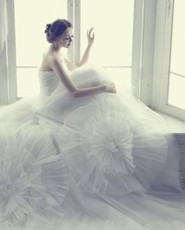发布时间:05-22 美编组:味很美美食网 来源:互联网

They haven’t always been white. With a new exhibition on bridal gowns
opening at the V&A, Lindsay Baker investigates the trends and taboos of
connubial chic.
It’s the default setting for brides in Western culture, but what does the ubiquitous white wedding dress actually represent? Not quite what we have always assumed, it turns out. The tradition of brides wearing white has never symbolised virginity or purity, according to a new exhibition that explores the garment’s history – the white bridal gown’s primary function was ostentatiousness.
“The connotation of purity was not important,” curator Edwina Ehrman tells BBC Culture. “It was about wealth. Throughout the 18th and 19th Century, women who could afford it got married in white.” In the days when washing was done painstakingly by hand with a washboard, a white dress was almost impossible to clean thoroughly. “It was a garment you just wore once, so it was only for the very wealthy.” The exhibition at London’s Victoria & Albert Museum, Wedding Dresses 1775-2014 shows how wedding dresses have changed in tune with fashion and society over the centuries – and also upends some of our long-held assumptions along the way.
The white (or ivory) wedding dress – popularised by Queen Victoria, who wore one at her wedding to Prince Albert in 1840 – has certainly endured. There’s no denying its totemic power. For many brides it encapsulates a hopeful, romantic nostalgia, and many designers. “It can have a transformative effect,” says Ehrman. “And if you’ve already been living with your partner or even if you’ve had children you may want to wear white at your wedding because you feel it marks a new phase in your relationship.”
White is the warmest colour
So quintessentially bridal has the white dress become that now when a bride chooses to tie the knot wearing another colour, it’s considered daring and rebellious: think burlesque dancer Dita Von Teese in her purple, corsetted dress by Vivienne Westwood, for instance; singer Gwen Stefani in a dramatic dip-dyed number by John Galliano; or actresses Anne Hathaway, Jessica Biel and Reese Witherspoon all of whom recently wed in unconventional pink. And when designers Oscar de la Renta and Vera Wang recently debuted non-white wedding-dress collections, it was viewed as a radical move in the conservative bridal-wear industry.
Yet getting married in pink, purple, yellow, red (the typical bridal gown colour in China) or any other colour for that matter is nothing new in Western culture, nor particularly irreverent, says Ehrman. “Over the centuries, brides who were interested in fashion have often got married in different colours. And they would wear them many times afterwards, altering them over the years to fit in with fashion, or to fit a changing figure.” And it was common for women not to buy a new dress for the occasion, but to simply get married in their best existing outfit.
Bridal fashion adapted to wartime as best it could. “People did what they could during World War II,” explains Ehrman. “They would borrow a dress or wear their service uniform. Women in the armed forces could also hire a dress, and some brides made dresses out of curtain fabric. We have an example in the show of a buttercup-print dress made of lightweight upholstery fabric.”
Post-war, the mid-calf ballerina-length design became popular, favoured by women who had careers. There were some spectacular one-off gowns, too. Margaret Whigam, one of the first It girls, wore a big, showy gown by Norman Hartnell. “She was beautiful, rich and she loved the camera – she was the perfect client for Hartnell,” says Ehrman. “That was not a garment that could be altered for another occasion.”
In the swinging 1960s, singer Lulu sported a white hooded, fur-trimmed maxi coat over a mini dress and high boots. The Thea Porter-designed empire-line dress displayed in the show – “demure but flirty” as Ehrman puts it – in devore velvet, is quintessentially 1970s. “The reason the white wedding dress has survived is because it can evolve and remain fashionable –it persists because it can be reinvented.”
Designer Jenny Packham agrees. “The most memorable wedding outfits for me are those that define an era from a fashion perspective,” she says. “Bianca Jagger in that white suit, Audrey Hepburn in a mini dress and head scarf.” Packham designs bridal wear as well as eveningwear (and is a favourite with many high-profile women, including the Duchess of Cambridge).
So what era influences Packham’s bridal wear the most? “The 1930s are always a great source of inspiration – a wonderfully decadent and glamorous era between the wars, it was a design explosion of divine proportions.”
And how does she predict the wedding dress will evolve? “The bridal dress must stand out as a piece of clothing… At the moment there is a comfortable stand-off between the red carpet and the aisle. Neither wants to look like the other.”
Tags: tokyo hot n0487 芒仔网 高隽雅 含羞忍辱的保洁员 电机小子3部全集 姚广孝擒龙 北京人妖ts美模雅琦 风流逍遥侯 丁香花园果果秀 张伦硕大鸟照 钟莉颖 ed2k 肉色兵团 铁腕总裁猎冷妻 防身麻醉药 淘漫网 昌平五中贴吧 美设门 jiuchengqingse
上下篇
上一篇:自体脂肪丰胸塑造挺拔双峰
下一篇:奈瑞儿全心为您甄选

